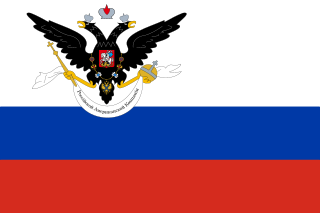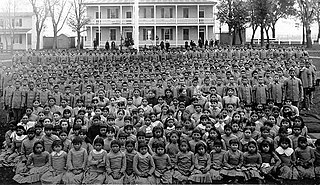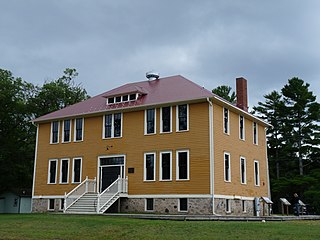Related Research Articles

The Russian colonization of North America covers the period from 1732 to 1867, when the Russian Empire laid claim to northern Pacific Coast territories in the Americas. Russian colonial possessions in the Americas are collectively known as Russian America. Russian expansion eastward began in 1552, and in 1639 Russian explorers reached the Pacific Ocean. In 1725, Emperor Peter the Great ordered navigator Vitus Bering to explore the North Pacific for potential colonization. The Russians were primarily interested in the abundance of fur-bearing mammals on Alaska's coast, as stocks had been depleted by over hunting in Siberia. Bering's first voyage was foiled by thick fog and ice, but in 1741 a second voyage by Bering and Aleksei Chirikov made sight of the North American mainland.

Petersburg is a census-designated place (CDP) in and essentially the borough seat of Petersburg Borough, Alaska, United States. The population was 3,043 at the 2020 census, up from 2,948 in 2010.

The City and Borough of Wrangell is a borough in Alaska, United States. As of the 2020 census the population was 2,127, down from 2,369 in 2010.

Alaska Natives or Alaskan Natives are indigenous peoples of Alaska and include Iñupiat, Yupik, Aleut, Eyak, Tlingit, Haida, Tsimshian, and a number of Northern Athabaskan cultures. They are often defined by their language groups. Many Alaska Natives are enrolled in federally recognized Alaska Native tribal entities, who in turn belong to 13 Alaska Native Regional Corporations, who administer land and financial claims.

Alexander Andreyevich Baranov, sometimes spelled Aleksandr or Alexandr and Baranof, was a Russian trader and merchant, who worked for some time in Siberia. He was recruited by the Shelikhov-Golikov Company for trading in Russian America, beginning in 1790 with a five-year contract as manager of the outpost. He continued to serve past the end date of his contract.

Sheldon Jackson was a Presbyterian minister, missionary, and political leader. During this career he travelled about one million miles and established more than one hundred missions and churches, mostly in the Western United States. He is best remembered for his extensive work in Colorado and the Alaska Territory, and for his efforts to suppress Native American languages.

Sheldon Jackson College (SJC) was a small private college located on Baranof Island in Sitka, Alaska, United States. Founded in 1878, it was the oldest institution of higher learning in Alaska and maintained a historic relationship with the Presbyterian Church. The college was named in honor of Rev. Sheldon Jackson, an early missionary and educational leader in Alaska.

The Battle of Sitka was the last major armed conflict between Russians and Alaska Natives, and was initiated in response to the destruction of a Russian trading post two years before. The primary combatant groups were the Kiks.ádi Clan of Sheetʼká Xʼáatʼi of the Tlingit nation and agents of the Russian-American Company assisted by the Imperial Russian Navy.

Russian America was the name for the Russian Empire's colonial possessions in North America from 1799 to 1867. It consisted mostly of present-day Alaska in the United States, but also included small outposts in California, including Fort Ross, and three forts in Hawaii, including Russian Fort Elizabeth. Settlements were concentrated in Alaska, including the capital, Novo-Arkhangelsk, which is now Sitka.

Mt. Edgecumbe High School is a public boarding high school in Sitka, Alaska in the United States. Located on Japonski Island, across Sitka Harbor from the northwestern corner of downtown Sitka, the school is situated on a portion of Sitka's former World War II-era military installations. Established in 1947 after the military abandoned the area, the school was originally operated by the federal Bureau of Indian Affairs (BIA) as part of a network of boarding high schools, which included schools in Eklutna and Wrangell. After several decades of operation by the BIA, the school was briefly closed in the 1980s before being reopened by the Alaska Department of Education, which operates it today.
The Rev. Edward Marsden (1869–1932) was a Canadian-American missionary and member of the Tsimshian nation who became the first Alaska Native to be ordained in the ministry.

The history of the Tlingit includes pre- and post-contact events and stories. Tradition-based history involved creation stories, the Raven Cycle and other tangentially-related events during the mythic age when spirits transformed back and forth from animal to human and back, the migration story of arrival at Tlingit lands, and individual clan histories. More recent tales describe events near the time of the first contact with Europeans. European and American historical records come into play at that point; although modern Tlingit have access to those historical records, however, they maintain their own record of ancestors and events important to them against the background of a changing world.

The Alaska Native Brotherhood (ANB) and its counterpart, the Alaska Native Sisterhood (ANS), are two nonprofit organizations founded to address racism against Alaska Native peoples in Alaska. ANB was formed in 1912 and ANS founded three years later. For the first half of the 20th century, they were the only organizations working for the civil rights of Alaska Natives in the territory and state.

American Indian boarding schools, also known more recently as AmericanIndian Residential Schools, were established in the United States from the mid 17th to the early 20th centuries with a primary objective of "civilizing" or assimilating Native American children and youth into Euro-American culture. In the process, these schools denigrated Native American culture and made children give up their languages and religion. At the same time the schools provided a basic Western education. These boarding schools were first established by Christian missionaries of various denominations. The missionaries were often approved by the federal government to start both missions and schools on reservations, especially in the lightly populated areas of the West. In the late 19th and early 20th centuries especially, the government paid religious orders to provide basic education to Native American children on reservations, and later established its own schools on reservations. The Bureau of Indian Affairs (BIA) also founded additional off-reservation boarding schools based on the assimilation model. These sometimes drew children from a variety of tribes. In addition, religious orders established off-reservation schools.
Walter Alexander Soboleff was a Tlingit scholar, elder and religious leader. Soboleff was the first Native Alaskan to become an ordained Presbyterian minister.
Alaska Natives are a group of indigenous people that live in the state of Alaska and trace their heritage back to the last two great migrations that occurred a thousand years ago. The Native community can be separated into six large tribes and a number of smaller tribes, including the Iñupiat, Yup'ik, Aleut, Tlingit, Haida, Tsimshian, and others. Even with just a small amount of communities that make up the entire population, there were more than 300 different languages that the Natives used to communicate with one another.

The Government Boarding School at Lac du Flambeau in Lac du Flambeau, Wisconsin was a school where Native American children of the Ojibwe, Potowatomi and Odawa peoples were taught mainstream American culture from 1895 to 1932. It served grades 1-8, teaching both academic and practical subjects, intended to give children skills needed for their rural societies. The school was converted in 1932 to a day school, serving only Ojibwe children and those nearby of other tribes.

Matilda Kinnon "Tillie"' Paul Tamaree was a Tlingit translator, civil rights advocate, educator, and Presbyterian church elder.
Elaine Elizabeth Abraham was a Tlingit elder and registered nurse who contributed to improving health care delivery in rural Alaska. Later active professionally in the field of education, she assisted with the creation of the Alaska Native Language Center, and, as a statewide administrator at the University of Alaska, in 1976, led the establishment of community colleges in underserved parts of the state.

The Wrangell Bombardment was the bombardment of the Stikine village of Old Wrangell by the United States Army in 1869. The army issued an ultimatum to the villagers, demanding they deliver a Stikine named Scutd-doo to justice following the retribution murder of Leon Smith by Scutd-doo. Scutd-doo's son, Lowan, had earlier been killed by soldiers following an altercation in which he bit off a finger of the wife of the quartermaster of Fort Wrangell.
References
- 1 2 3 "World War II Aleut Relocation Camps in Southeast Alaska - Chapter 5: Wrangell Institute". National Park Service. Retrieved 6 January 2019.Gives a very thorough history of the site and buildings, including illustrations and floorplans
- ↑ Young, S. Hall. 1927. Hall Young of Alaska. Fleming Revell
- ↑ Wells, Don; Wells, Diane (14 April 2014). "The Indian Industrial and Boarding Schools – Part 4". Smoke Signals: News and views from Big Canoe and around North Georgia. Retrieved 6 January 2019.
- 1 2 3 Bolton, Aaron (13 July 2016). "Why a Wrangell boarding school plan stirs bad memories — and opportunity". Ktoo Public Media. Retrieved 6 January 2019.
- ↑ Bolton, Aaron (31 May 2016). "Former Wrangell Institute property could see another boarding school". Alaska Public Media. Retrieved 6 January 2019.